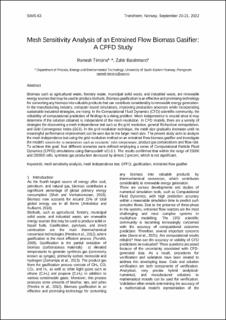| dc.contributor.author | Timsina, Ramesh | |
| dc.contributor.author | Barahmand, Zahir | |
| dc.date.accessioned | 2023-06-05T11:23:32Z | |
| dc.date.available | 2023-06-05T11:23:32Z | |
| dc.date.created | 2022-12-09T10:58:12Z | |
| dc.date.issued | 2022 | |
| dc.identifier.citation | Timsina, R., & Barahmand, Z. (2022, 20.-21. september). Mesh Sensitivity Analysis of an Entrained Flow Biomass Gasifier: A CPFD Study [Paperpresentasjon]. Proceedings of the 63rd International Conference of Scandinavian Simulation Society, SIMS 2022, Trondheim. | en_US |
| dc.identifier.isbn | 978-91-7929-545-5 | |
| dc.identifier.uri | https://hdl.handle.net/11250/3069921 | |
| dc.description.abstract | Biomass such as agricultural waste, forestry waste, municipal solid waste, and industrial waste, are renewable energy sources that may be used to produce biofuels. Biomass gasification is an effective and promising technology for converting any biomass into valuable products that can contribute considerably to renewable energy generation. In the manufacturing industry, computer-based simulations, improving production processes while incorporating sustainable industrial strategies, are rising. In the Computational Fluid Dynamics (CFD) scientific community, the reliability of computational prediction of findings is a rising problem. Mesh independence is crucial since it may determine if the solution obtained is independent of the mesh resolution. In CFD models, there are a variety of strategies for discovering a mesh independence test such as the grid resolution, general Richardson extrapolation, and Grid Convergence Index (GCI). In the grid resolution technique, the mesh size gradually increases until no meaningful performance improvement can be seen due to the larger mesh size. The present study aims to analyze the mesh independence test using the grid resolution method on an entrained flow biomass gasifier and investigate the model's sensitivity to parameters such as reactants’ inlet temperature, product gas compositions and flow rate. To achieve this goal, four different scenarios were defined employing a series of Computational Particle Fluid Dynamics (CPFD) simulations using Barracuda® v21.0.1. The results confirmed that within the range of 25000 and 200000 cells, synthesis gas production decreased by almost 2 percent, which is not significant. | en_US |
| dc.language.iso | eng | en_US |
| dc.relation.ispartof | Proceedings of the 63rd International Conference of Scandinavian Simulation Society, SIMS 2022, Trondheim, Norway, September 20-21, 2022 | |
| dc.rights | Navngivelse 4.0 Internasjonal | * |
| dc.rights.uri | http://creativecommons.org/licenses/by/4.0/deed.no | * |
| dc.title | Mesh Sensitivity Analysis of an Entrained Flow Biomass Gasifier: A CPFD Study | en_US |
| dc.type | Chapter | en_US |
| dc.description.version | publishedVersion | en_US |
| dc.rights.holder | © 2022 Ramesh Timsina, Zahir Barahmand. | en_US |
| dc.identifier.doi | https://doi.org/10.3384/ecp192053 | |
| dc.identifier.cristin | 2091110 | |
| cristin.ispublished | true | |
| cristin.fulltext | original | |
| cristin.fulltext | original | |
| cristin.qualitycode | 1 | |

